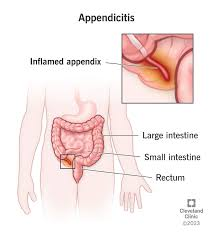A client with suspected appendicitis is waiting for surgery. What should the nurse do?
Offer the client a warm beverage.
Monitor the client's gag reflex.
Help the client to a side-lying position with knees flexed.
Bring the client a heating pad to apply to the abdomen for comfort.
The Correct Answer is C
Choice A reason:
Offering a warm beverage to a client with suspected appendicitis is not advisable. Preoperative clients are typically required to have an empty stomach to reduce the risk of aspiration during anesthesia. Introducing fluids or food could delay surgery and increase the risk of complications.
Choice B reason:
Monitoring the client's gag reflex is not a priority in the care of a client with suspected appendicitis. The gag reflex is more relevant in neurological assessments or when evaluating swallowing function, not in the context of appendicitis.
Choice C reason:
Helping the client to a side-lying position with knees flexed can provide comfort and may help relieve abdominal pain. This position reduces tension on the abdominal muscles and can be a supportive measure while the client awaits surgery.
Choice D reason:
Applying a heating pad to the abdomen is contraindicated in clients with suspected appendicitis. Heat can cause the appendix to rupture, leading to peritonitis, which is a severe and potentially life-threatening complication. Therefore, this action should be avoided.

Nursing Test Bank
Naxlex Comprehensive Predictor Exams
Related Questions
Correct Answer is D
Explanation
Choice A reason:
Administering oxygen using a non-rebreather mask is a subsequent step if initial measures do not improve fetal heart rate decelerations. It can help increase the amount of oxygen available to the fetus. Oxygen administration is a supportive measure that can be used if there are signs of fetal distress. In the scenario described, where the fetal heart rate slows after the start of a contraction with the lowest rate occurring after the peak, it suggests late decelerations, which are often associated with uteroplacental insufficiency. Administering oxygen can help increase the fetal oxygen reserve and is a common intervention during labor when there are concerns about fetal well-being.
Choice B reason:
Increasing the rate of maintenance IV infusion is typically considered when there is a concern for maternal hypotension or dehydration, which may not be the immediate cause of the observed fetal heart rate pattern. Increasing the rate of an IV infusion can help improve maternal hydration and blood pressure, which in turn can enhance placental perfusion. However, this intervention is more indirect and may not provide the immediate response needed to address fetal heart rate decelerations. It is typically considered after more direct interventions, such as repositioning the mother, have been attempted.
Choice C reason:
Elevating the client's legs can help improve venous return to the heart, potentially increasing maternal cardiac output and blood flow to the placenta. While this can be beneficial, it is not the primary intervention for late decelerations. Repositioning the mother to improve uteroplacental circulation is generally the first step.
Choice D reason:
Placing the client in the lateral position is often the first action taken when late decelerations are observed. This position helps improve uteroplacental blood flow and can quickly address potential issues related to fetal oxygenation. This position helps to relieve pressure on the inferior vena cava and aorta, which can be compressed by the gravid uterus, especially in the supine position. Relieving this pressure helps to improve uteroplacental circulation and can quickly address the cause of late decelerations, which is often related to compromised blood flow to the placenta.
Correct Answer is ["A","B","C","E"]
Explanation
Choice A reason:
Obesity is a significant risk factor for gout. It can lead to increased production and decreased excretion of uric acid, which in turn can cause gout attacks. The normal body mass index (BMI) range is 18.5 to 24.9, and a BMI of 30 or above is considered obese.
Choice B reason:
Regular consumption of beer can increase the risk of gout. Beer is high in purines, which the body breaks down into uric acid, and alcohol can reduce the excretion of uric acid by the kidneys. Moderation in alcohol consumption is advised, with the recommendation being up to one drink per day for women and up to two drinks per day for men.
Choice C reason:
Thiazide diuretics are associated with an increased risk of gout. They can decrease the kidney's ability to remove uric acid from the body, leading to its accumulation. When prescribing thiazide diuretics, healthcare providers often monitor uric acid levels and consider alternative medications if the patient has a history of gout.
Choice D reason:
Depression is not directly identified as a risk factor for developing gout. However, some lifestyle factors associated with depression, such as poor diet and inactivity, could indirectly increase the risk.
Choice E reason:
Hypertension is a known risk factor for gout. High blood pressure can impair kidney function, which is responsible for excreting uric acid, thus leading to hyperuricemia and gout. The normal range for blood pressure is considered to be below 120/80 mmHg.
Whether you are a student looking to ace your exams or a practicing nurse seeking to enhance your expertise , our nursing education contents will empower you with the confidence and competence to make a difference in the lives of patients and become a respected leader in the healthcare field.
Visit Naxlex, invest in your future and unlock endless possibilities with our unparalleled nursing education contents today
Report Wrong Answer on the Current Question
Do you disagree with the answer? If yes, what is your expected answer? Explain.
Kindly be descriptive with the issue you are facing.
